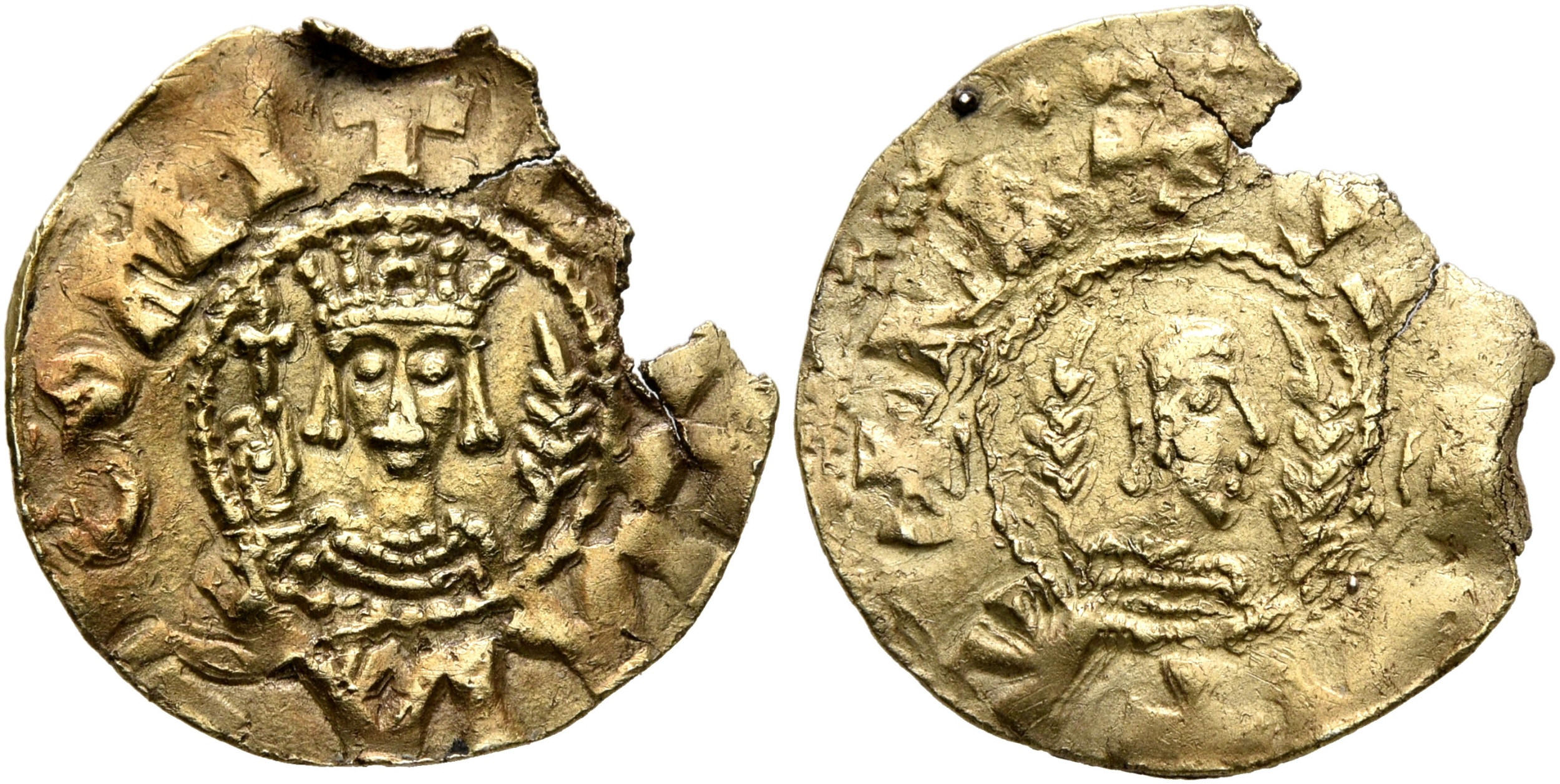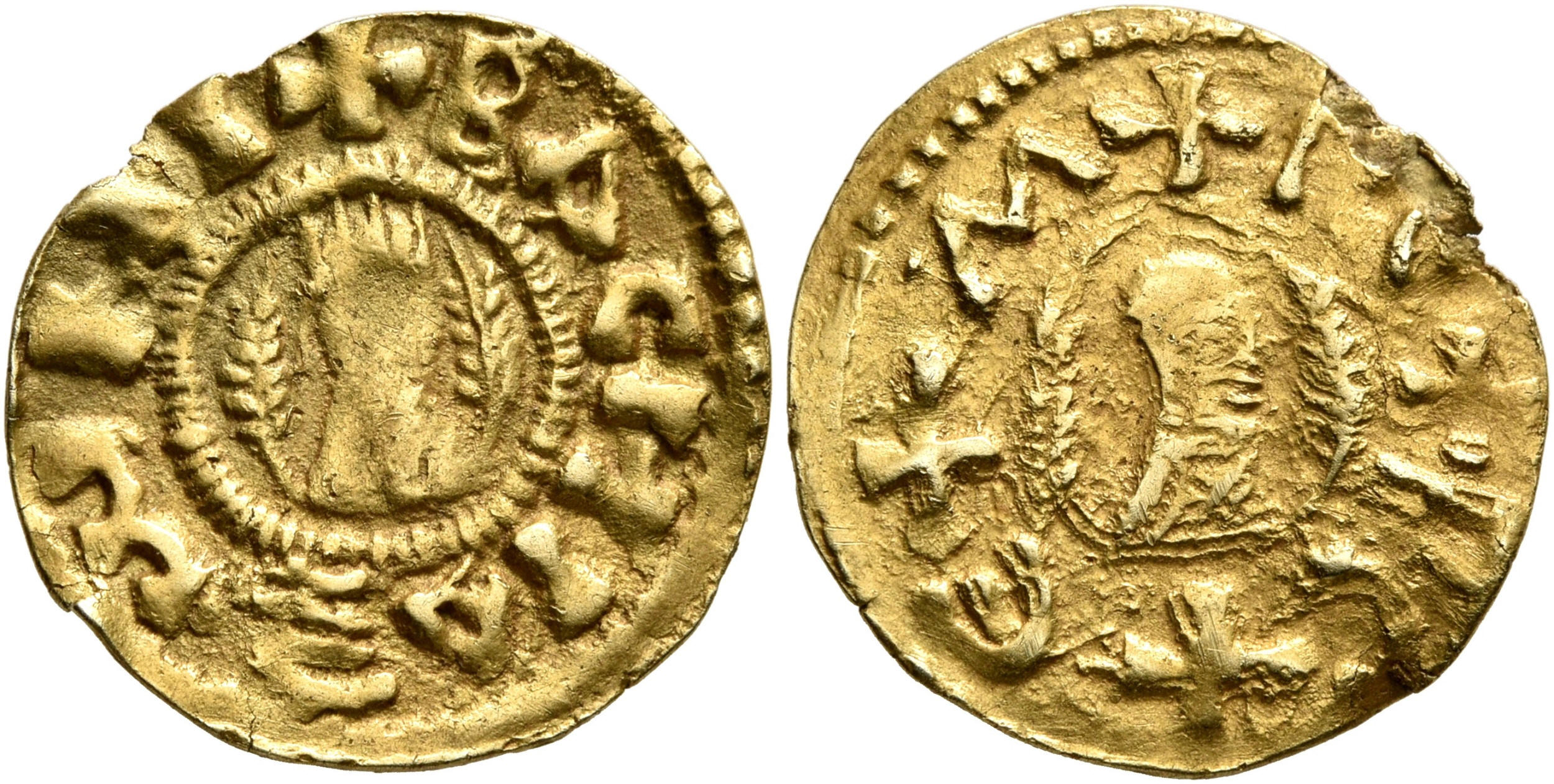

Gersem, circa 580s. Chrysos (Electrum, 17 mm, 1.21 g, 9 h). ✠BACIΛI AξⲰΜΙ Draped bust of Gersem facing, wearing crown surmounted by cross and decorated with pendilia, holding globus cruciger in his right hand; to right, ear of barley; all within circular border. Rev. ✠ΓЄ✠PC✠Є✠Μ (?) Draped bust of Gersem to right, wearing tight-fitting head cloth and circular earring; to left and right, ears of barley; all within circular border. Hahn, Aksumite, 50 = Hahn & Keck, MAKS, pl. 14, 80.1 = Munro-Hay, AC, type 145 = Vaccaro 64 ( this coin ). Unique. A spectacular coin of great historical interest and intriguing iconography, certainly one of the highlights in the entire Axumite series. Some edge chips and flan cracks and the reverse slightly double struck, otherwise, very fine.
From the Dr. Stephan Coffman Collection, the Maekelay-Tigray Collection, Roma E-Auction 69, 16 March 2020, 584, and from the collection of Francesco Vaccaro (1903-1990).
This unique coin is undoubtedly one of the highlights of the Dr. Coffman Collection and arguably of Axumite coinage as a whole. The obverse in particular completely departs from the highly standardized iconography of the gold coins by showing a frontal bust of the king wearing a cross-tipped crown with pendilia and holding a globus cruciger. This clearly copies a Byzantine prototype, most likely the solidi of Tiberius II Constantine (574-582) or Maurice Tiberius (582-602), if the dating of Gersem and the reading of his name on this coin are correct. Still, we are not dealing with a slavish copy, as the ubiquitous Axumite ear of barley is retained, the globus cruciger is almost reduced to a plain cross, and the crown has a decidedly different shape.
Gersem also struck a more regular gold coinage (see lot 338 below), and it has been speculated that the present piece was part of an extraordinary emission, perhaps one related to a Byzantine embassy, which would also explain its extreme rarity. All in all, this coin is a fantastic witness to the intercultural contacts which still existed between Axum and the outside world during this time, and it shows the openness of the Axumite mint in adapting new coin designs to its own needs. As for the king's name, it is possibly derived from the biblical Gershom, who was the eldest son of Moses with Zipporah. Interestingly, the latter is sometimes seen as Ethiopian, based on Numeri 12:1, which states that Miriam and Aaron criticized Moses for having taken a 'Cushite' wife.
Leu, okt. 2023, lot 337, 16000 CHF (Euro 16833)

★ Extremely rare, just six examples cited by Hahn & Keck, of which only three in private hands ★
Gersem, circa 580s. Chrysos (Gold, 16 mm, 1.24 g, 12 h). ✠ΒΑCHI ΑξⲰΜΙ Draped half-length bust of Gersem to right, wearing tiara and circular earring; to left and right, ears of barley; all within circular border. Rev. ✠ΓЄ✠ΡC✠Є•Μ Draped half-length bust of Gersem to right, wearing tight-fitting head cloth and circular earring; to left and right, ears of barley; all within circular border. Hahn, Aksumite, 49. Hahn & Keck, MAKS, 81.5 = Phaidra 1190548 ( this coin ). Munro-Hay, AC, type 146. Extremely rare, just six examples cited by Hahn & Keck, of which only three in private hands. Flan crack, edge chip and struck from somewhat worn dies, otherwise, about very fine.
From the Dr. Stephan Coffman Collection, the Maekelay-Tigray Collection, Roma XXII, 7 October 2021, 81, and reportedly from the collection of Francesco Vaccaro (1903-1990).
Next to a highly unusual emission of gold chrysoi (see lot 337 above), Gersem also struck a more regular issue of gold chrysoi, but with the curious detail that the inner circle is missing from the reverse, while present on the obverse. All of his gold coins are extremely rare, perhaps a first indication that international trade was being disrupted by the intrusion of the Sasanian Empire in the Red Sea area during this time (see also lot 334 above).
Leu, okt. 2023, lot 338, 16000 CHF (Euro 16833)